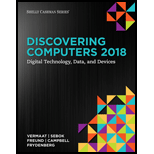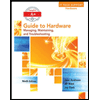
MindTap Computing, 1 term (6 months) Printed Access Card for Vermaat/Sebok/Freund/Campbell Frydenberg's Discovering Computers 2018 (MindTap Course List)
18th Edition
ISBN: 9781337285193
Author: Vermaat, Misty E.; Sebok, Susan L.; Freund, Steven M.; Campbell, Jennifer T.; Frydenberg, Mark
Publisher: Cengage Learning
expand_more
expand_more
format_list_bulleted
Question
Chapter 6, Problem 23SG
Program Plan Intro
Memory module:
- Memory module is a tiny circuit board that contains Dynamic RAM (DRAM) integrated circuits that are fixed into the memory slots on a motherboard.
- It is used to store temporary data while the computer executes.
- It is the computer part that holds the Random Access Memory (RAM) and is represented in megabytes or gigabytes.
Expert Solution & Answer
Want to see the full answer?
Check out a sample textbook solution
Students have asked these similar questions
Please draw the diagram where it is asked to be drawn. Don't just describe how to do it.
C. Homework Assignment
Task: Write a one-page CV using the provided template.
Steps:
1. Use the CV guide to structure your CV.
2. Fill in each section with real information about yourself.
3. Format your CV neatly and use professional language.
4. Submit to the instructor before the next class
Simulate on a vertical time axis (with events labeled with the senders names A-D) the contention period of FOUR equally distanced Ethernet stations that all attempt to transmit at T=0 a minimally sized frame, in the style of the binary Exponential Backoff Algorithm. Assume that time is measured in slot times, and that exactly one slot time is needed to detect a collision (so that if two stations transmit at T=1 and collide, and one of them chooses a backoff time k=0, then that station will transmit again at T=2).
Use as coin flip (source of randomness) an ID written in binary.
use the bits in order from the least significant to the most significant. If for a given coin throw you need k bits, use the least significant ID bit extracted in the corresponding group of bits, as the least significant bit of the coin thrown.
Start be writing the ID, which is 904012207
As example of the expected answer format,
with the random sequence R: 100101010101001011001010 01 01011 10010 1010 1010 010…
Chapter 6 Solutions
MindTap Computing, 1 term (6 months) Printed Access Card for Vermaat/Sebok/Freund/Campbell Frydenberg's Discovering Computers 2018 (MindTap Course List)
Ch. 6 - Prob. 1SGCh. 6 - Prob. 2SGCh. 6 - Prob. 3SGCh. 6 - Prob. 4SGCh. 6 - Prob. 5SGCh. 6 - Prob. 6SGCh. 6 - Prob. 7SGCh. 6 - Prob. 8SGCh. 6 - Prob. 9SGCh. 6 - Prob. 10SG
Ch. 6 - Prob. 11SGCh. 6 - Prob. 12SGCh. 6 - Prob. 13SGCh. 6 - Prob. 14SGCh. 6 - Prob. 15SGCh. 6 - Prob. 16SGCh. 6 - Prob. 17SGCh. 6 - Prob. 18SGCh. 6 - Prob. 19SGCh. 6 - Prob. 20SGCh. 6 - Prob. 21SGCh. 6 - Prob. 22SGCh. 6 - Prob. 23SGCh. 6 - Prob. 24SGCh. 6 - Prob. 25SGCh. 6 - Prob. 26SGCh. 6 - Prob. 27SGCh. 6 - Prob. 28SGCh. 6 - Prob. 29SGCh. 6 - Prob. 30SGCh. 6 - Prob. 31SGCh. 6 - Prob. 32SGCh. 6 - Prob. 33SGCh. 6 - Prob. 34SGCh. 6 - Prob. 35SGCh. 6 - Prob. 36SGCh. 6 - Prob. 37SGCh. 6 - Prob. 38SGCh. 6 - Describe how bus width and word size affect and...Ch. 6 - Prob. 40SGCh. 6 - Prob. 41SGCh. 6 - Prob. 42SGCh. 6 - Prob. 43SGCh. 6 - Prob. 44SGCh. 6 - Prob. 45SGCh. 6 - Prob. 46SGCh. 6 - Prob. 47SGCh. 6 - Prob. 1TFCh. 6 - Prob. 2TFCh. 6 - Prob. 3TFCh. 6 - Prob. 4TFCh. 6 - Prob. 5TFCh. 6 - Prob. 6TFCh. 6 - Prob. 7TFCh. 6 - Prob. 8TFCh. 6 - Prob. 9TFCh. 6 - Prob. 10TFCh. 6 - Prob. 11TFCh. 6 - Prob. 12TFCh. 6 - Prob. 1MCCh. 6 - Prob. 2MCCh. 6 - Prob. 3MCCh. 6 - Prob. 4MCCh. 6 - Prob. 5MCCh. 6 - Prob. 6MCCh. 6 - Prob. 7MCCh. 6 - Prob. 8MCCh. 6 - Prob. 1MCh. 6 - Prob. 2MCh. 6 - Prob. 3MCh. 6 - Prob. 4MCh. 6 - Prob. 5MCh. 6 - Prob. 6MCh. 6 - Prob. 7MCh. 6 - Prob. 8MCh. 6 - Prob. 9MCh. 6 - Prob. 10MCh. 6 - Prob. 2CTCh. 6 - Prob. 3CTCh. 6 - Prob. 4CTCh. 6 - Prob. 5CTCh. 6 - Prob. 6CTCh. 6 - Prob. 7CTCh. 6 - Prob. 8CTCh. 6 - Prob. 9CTCh. 6 - Prob. 10CTCh. 6 - Prob. 11CTCh. 6 - Prob. 12CTCh. 6 - Prob. 13CTCh. 6 - Prob. 14CTCh. 6 - Prob. 15CTCh. 6 - Prob. 16CTCh. 6 - Prob. 17CTCh. 6 - Prob. 18CTCh. 6 - Prob. 19CTCh. 6 - Prob. 20CTCh. 6 - Prob. 21CTCh. 6 - Prob. 22CTCh. 6 - Prob. 23CTCh. 6 - Prob. 24CTCh. 6 - Prob. 25CTCh. 6 - Prob. 26CTCh. 6 - Prob. 27CTCh. 6 - Prob. 1PSCh. 6 - Prob. 2PSCh. 6 - Prob. 3PSCh. 6 - Prob. 4PSCh. 6 - Prob. 5PSCh. 6 - Prob. 6PSCh. 6 - Prob. 7PSCh. 6 - Prob. 8PSCh. 6 - Prob. 9PSCh. 6 - Prob. 10PSCh. 6 - Prob. 11PSCh. 6 - Prob. 1.1ECh. 6 - Prob. 1.2ECh. 6 - Prob. 1.3ECh. 6 - Prob. 2.1ECh. 6 - Prob. 2.2ECh. 6 - Prob. 2.3ECh. 6 - Prob. 3.1ECh. 6 - Prob. 3.2ECh. 6 - Prob. 3.3ECh. 6 - Prob. 4.1ECh. 6 - Prob. 4.2ECh. 6 - Prob. 4.3ECh. 6 - Prob. 5.1ECh. 6 - Prob. 5.2ECh. 6 - Prob. 5.3ECh. 6 - Prob. 2IRCh. 6 - Prob. 4IRCh. 6 - Prob. 5IRCh. 6 - Prob. 1CTQCh. 6 - Prob. 2CTQCh. 6 - Prob. 3CTQCh. 6 - Prob. 4CTQ
Knowledge Booster
Similar questions
- Big State University The Big State University course catalog reads as follows: "To enroll in MIS 260, which is an advanced course, a student must complete two prerequisites: MIS 120 and MIS 222. A student who completes either one of these prerequisites and obtains the instructor's permission, however, will be allowed to take MIS 260." Tasks 1. Create a decision table that describes the Big State University course catalog regarding eligibility for MIS 260. Show all possible rules. 2. Simplify the table you just created. Describe the results. 3. Draw a simplified decision tree to represent the Big State University catalog. Describe the results. 4. Why might you use a decision tree rather than a decision table?arrow_forwardWhat is the ALU result if the 4-bit ALU Control signal is 0100? What happens if the ALU Control signal is 0101?arrow_forward#include int main (void) { int i, *p, count } p = &count; = 10%; for (i = 5; i >= 0; i--) { count++; (*p) ++; } printf("count return 0; = %d, Have a wonderful day.\n", count); 1. [20 pts] What is the output of the program? Please explain why. 2. [15 pts] What is the gdb command to set a breakpoint in line 6 (p = &count;)? 3. [15 pts] Explain in your own words how the [break. need to use such command? ... if expr] command works. When might youarrow_forward
- Please run and debug the following program and answer the questions.arrow_forward(OnlineGDB) #include <stdio.h>int main(void) {int a;char *s;int v0 = 4, v1 = 5, v2 = 6, v3 = 1, v4 = 2;printf("Exercise 1:\n====================\n");switch(v0) {case 0: printf("Hello October\n"); break;case 1: printf("Go Kean!\n"); break;case 2: printf("Academic Building Center \n"); break;case 3: printf("UNION \n"); break;case 4: printf("Go ");case 5: printf("Kean! \n");default: printf("Have a great semester! \n"); break;}for(a=5; a<v1; a++) {printf("Kean");}printf("\n");if (v2 == 6) {s = "Go";}else {s = "Hello";}if(v3 != v4) {printf("%s Kean!\n",s);} else {printf("%s Computer Science!\n",s);}return 0;} Assume the following codes are added between line 36 (}) and line 38 (return 0;) v0>0 ? ++v1, ++v2 : --v3; Please give the values of v0, v1, v2, v3, and v4 after this line and explain the reason. You can test the program to verify your answer if you like.arrow_forward#include <stdio.h>int main(void) {int a;char *s;int v0 = 4, v1 = 5, v2 = 6, v3 = 1, v4 = 2;printf("Exercise 1:\n====================\n");switch(v0) {case 0: printf("Hello October\n"); break;case 1: printf("Go Kean!\n"); break;case 2: printf("Academic Building Center \n"); break;case 3: printf("UNION \n"); break;case 4: printf("Go ");case 5: printf("Kean! \n");default: printf("Have a great semester! \n"); break;}for(a=5; a<v1; a++) {printf("Kean");}printf("\n");if (v2 == 6) {s = "Go";}else {s = "Hello";}if(v3 != v4) {printf("%s Kean!\n",s);} else {printf("%s Computer Science!\n",s);}return 0;} Output: Exercise 1:====================Go Kean! Have a great semester! Go Kean! Please only modify the initial value of v0, v1, v2, v3 and v4 to get the following output. Youneed to show your program output (in the screenshot) and submit the code that youmodified.Exercise 1:====================Hello OctoberKeanHello Computer Science!arrow_forward
- (OnlineGDB) 1. Please read and run the following code and answer the questions.#include <stdio.h>int main(void) {int a;char *s;int v0 = 4, v1 = 5, v2 = 6, v3 = 1, v4 = 2;printf("Exercise 1:\n====================\n");switch(v0) {case 0: printf("Hello October\n"); break;case 1: printf("Go Kean!\n"); break;case 2: printf("Academic Building Center \n"); break;case 3: printf("UNION \n"); break;case 4: printf("Go ");case 5: printf("Kean! \n");default: printf("Have a great semester! \n"); break;}for(a=5; a<v1; a++) {printf("Kean");}printf("\n");if (v2 == 6) {s = "Go";}else {s = "Hello";}if(v3 != v4) {printf("%s Kean!\n",s);} else {printf("%s Computer Science!\n",s);}return 0;} What is the output of the program? Please explain why.arrow_forward1.[30 pts] Answer the following questions: a. [10 pts] Write a Boolean equation in sum-of-products canonical form for the truth table shown below: A B C Y 0 0 0 1 0 0 1 0 0 1 0 0 0 1 1 0 1 0 0 1 1 0 1 0 1 1 0 1 1 1 1 0 a. [10 pts] Minimize the Boolean equation you obtained in (a). b. [10 pts] Implement, using Logisim, the simplified logic circuit. Include an image of the circuitarrow_forwardIn the past, encryption and decryption were mostly done by substitution and permutation of letters in a text message. study those classic cryptographic schemes Then, develop an automatic cipher using Javascript The cipher should be able to perform the following tasks: generate keys encrypt a given plaintext message with a key selected from the list of keys generated decrypt a given ciphertext message with a known cipher keyarrow_forward
- List reasons why teachers should and shouldn’t be replaced by computers? State your response in a descriptive context. Provide five references from the with internet with your answers.arrow_forwardThe attached picture shows the RTCAPI memory mapped register which has the address 0x180. 1) Program the MCU's registers so that a) SIRC is the clock source b) the clock is divided by 16K c) the clock is enabled d) load is enabledarrow_forwardWhat is the ALU result if the 4-bit ALU Control signal is 0100? What happens if the ALU Control signal is 0101?arrow_forward
arrow_back_ios
SEE MORE QUESTIONS
arrow_forward_ios
Recommended textbooks for you
 Enhanced Discovering Computers 2017 (Shelly Cashm...Computer ScienceISBN:9781305657458Author:Misty E. Vermaat, Susan L. Sebok, Steven M. Freund, Mark Frydenberg, Jennifer T. CampbellPublisher:Cengage Learning
Enhanced Discovering Computers 2017 (Shelly Cashm...Computer ScienceISBN:9781305657458Author:Misty E. Vermaat, Susan L. Sebok, Steven M. Freund, Mark Frydenberg, Jennifer T. CampbellPublisher:Cengage Learning Principles of Information Systems (MindTap Course...Computer ScienceISBN:9781305971776Author:Ralph Stair, George ReynoldsPublisher:Cengage Learning
Principles of Information Systems (MindTap Course...Computer ScienceISBN:9781305971776Author:Ralph Stair, George ReynoldsPublisher:Cengage Learning Systems ArchitectureComputer ScienceISBN:9781305080195Author:Stephen D. BurdPublisher:Cengage Learning
Systems ArchitectureComputer ScienceISBN:9781305080195Author:Stephen D. BurdPublisher:Cengage Learning A+ Guide to Hardware (Standalone Book) (MindTap C...Computer ScienceISBN:9781305266452Author:Jean AndrewsPublisher:Cengage Learning
A+ Guide to Hardware (Standalone Book) (MindTap C...Computer ScienceISBN:9781305266452Author:Jean AndrewsPublisher:Cengage Learning Principles of Information Systems (MindTap Course...Computer ScienceISBN:9781285867168Author:Ralph Stair, George ReynoldsPublisher:Cengage Learning
Principles of Information Systems (MindTap Course...Computer ScienceISBN:9781285867168Author:Ralph Stair, George ReynoldsPublisher:Cengage Learning

Enhanced Discovering Computers 2017 (Shelly Cashm...
Computer Science
ISBN:9781305657458
Author:Misty E. Vermaat, Susan L. Sebok, Steven M. Freund, Mark Frydenberg, Jennifer T. Campbell
Publisher:Cengage Learning


Principles of Information Systems (MindTap Course...
Computer Science
ISBN:9781305971776
Author:Ralph Stair, George Reynolds
Publisher:Cengage Learning

Systems Architecture
Computer Science
ISBN:9781305080195
Author:Stephen D. Burd
Publisher:Cengage Learning

A+ Guide to Hardware (Standalone Book) (MindTap C...
Computer Science
ISBN:9781305266452
Author:Jean Andrews
Publisher:Cengage Learning

Principles of Information Systems (MindTap Course...
Computer Science
ISBN:9781285867168
Author:Ralph Stair, George Reynolds
Publisher:Cengage Learning